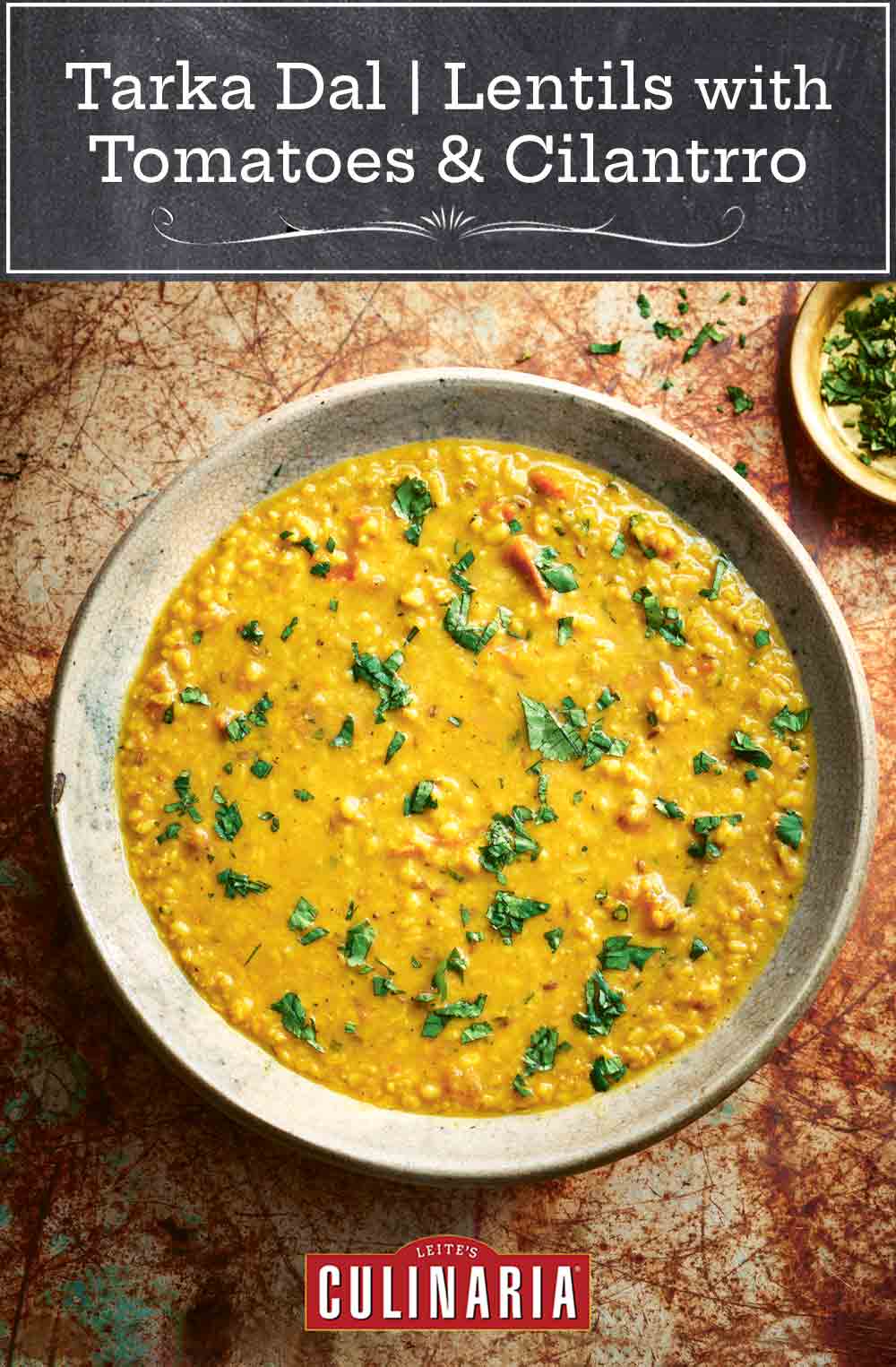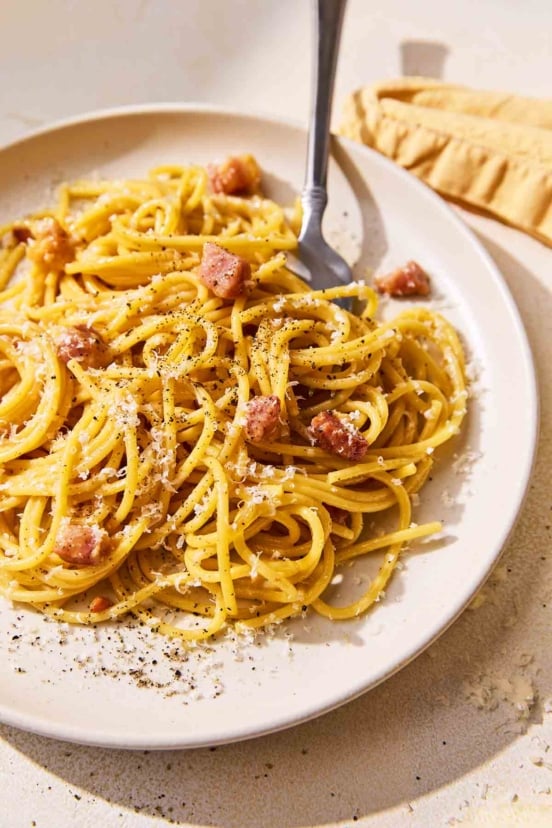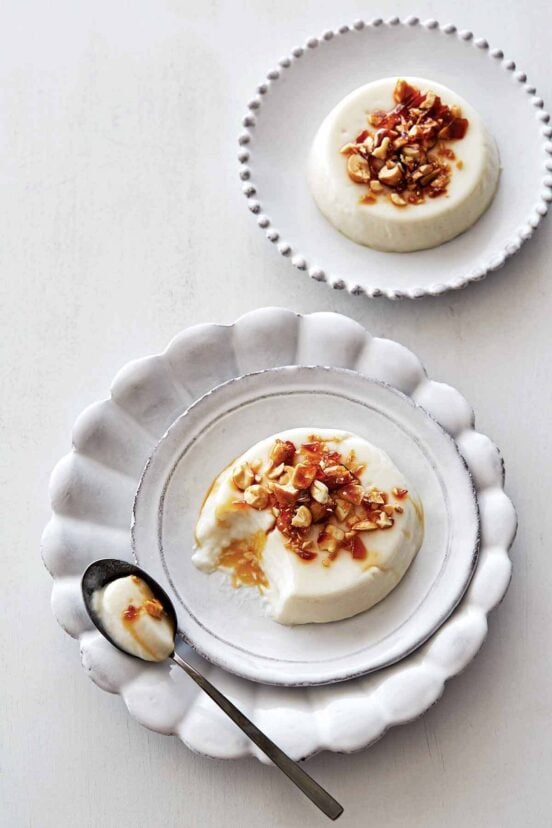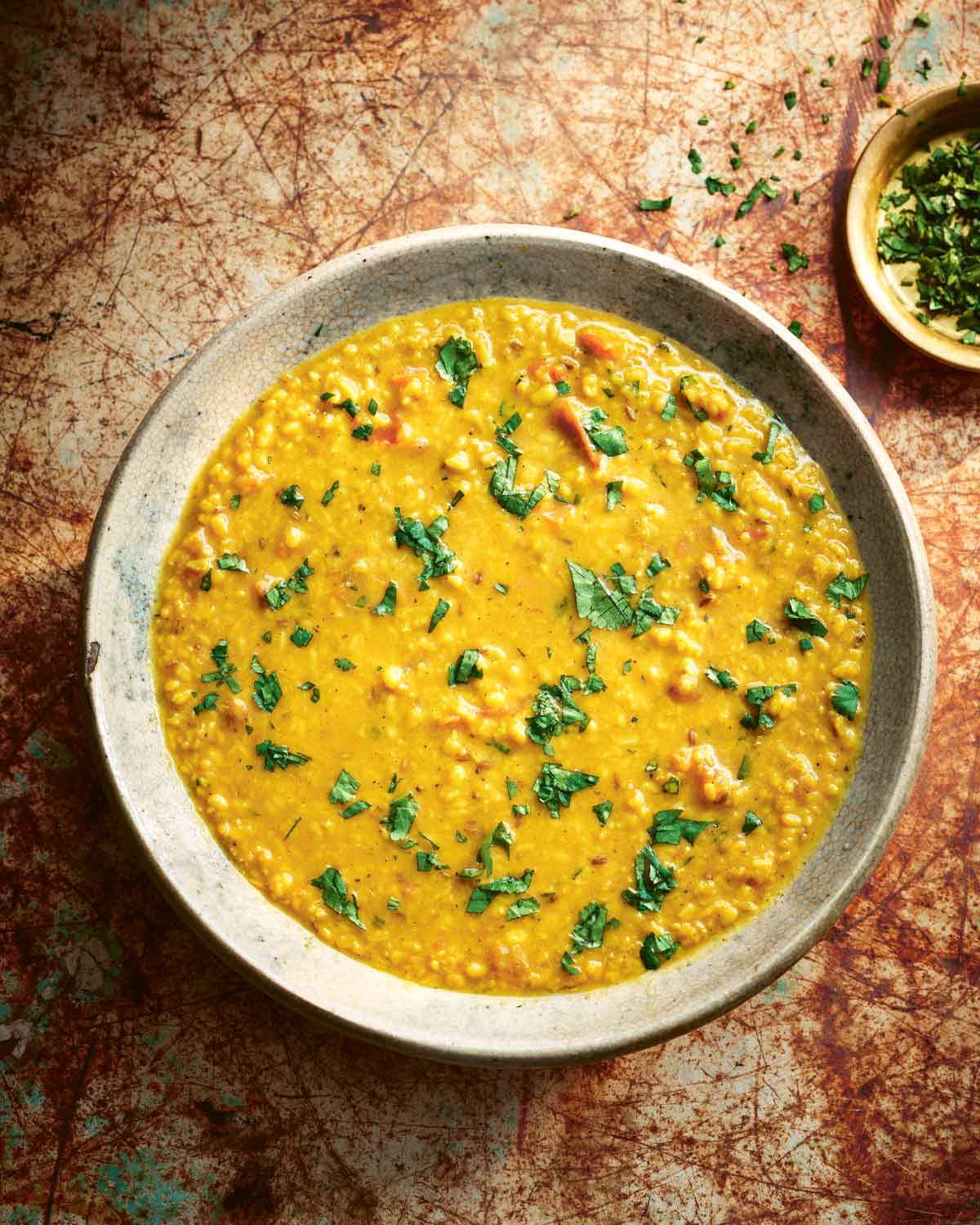
There are many versions of this north Indian recipe, as the name literally means “spiced, flavored lentils.” There are several Indian words that describe the process of tempering foods, including “tarka,” “tadka,” “vaghaar,” or “phodni.” Spices or ingredients, such as tomatoes, garlic, ginger, or chilies, are cooked in hot oil to extract and develop their flavor. Tempering can be done at the beginning of cooking, where for example, spices and onions are cooked before adding the main ingredient, or at the end, when for example, cumin seeds may be fried in oil and poured over a curry. The oil contains the aromatic oils extracted from the spices and becomes “flavored” itself.–Monisha Bharadwaj
Why should I temper my spices?
The process of tempering, or blooming, spices and aromatics is used throughout India. The method is the same but the oils and spices vary. It’s used for a simple reason—because it works magic. Blooming helps to release their volatile oils, enhancing the flavor in seconds. The mixture can then be used as the foundation for a dish, by adding other ingredients, or the intensely flavored oil can be used to finish—it’s beautiful drizzled over whatever you’re serving.

Tarka Dal ~ Lentils with Tomatoes and Cilantro
Ingredients
For the ginger-garlic paste
- 1/2 teaspoon grated or minced ginger
- 1 teaspoon grated or minced garlic
For the lentils
- 1 cup mung (moong) lentils
- 2 cups boiling water, plus more as needed
- 2 tablespoons mild vegetable oil
- 1 teaspoon cumin seeds
- 2 fresh green chile peppers, such as jalapeños, slit in half lengthwise and stalks left on
- 2 medium (10 oz) tomatoes, diced (seeds and all)
- 1 teaspoon ground turmeric
- 1 teaspoon garam masala
- A handful of fresh cilantro leaves, chopped
- Boiled rice or roti, for serving
Instructions
Make the ginger-garlic paste
- In a small bowl, stir together the ginger and garlic, mashing with the back of a spoon to thoroughly combine.
☞ TESTER TIP: If you’re making a larger batch of the ginger-garlic paste to keep a stash on hand, blitz the peeled and chopped ginger and garlic in a blender along with a little cold water to turn the blades until it makes a smooth paste. Scrape it into a clean jar, add enough oil to cover the surface (any oil will do), and keep in the fridge for up to a couple weeks, topping off the oil as needed.
Make the lentils
- Wash the lentils in a strainer under running cold water until the water runs clear. Put them into a heavy saucepan and then pour 2 cups boiling water over them (don’t salt the lentils at this stage, as they can take longer to cook if you do).
- Set over medium-high heat and bring to a boil. Reduce the heat and simmer until very soft, stirring occasionally and adding more boiling water as they absorb what’s in the saucepan, 30 to 45 minutes. You want to ensure that the lentils are submerged at all times. When the lentils are fully cooked, they should have almost completely disintegrated and the mixture will resemble oatmeal.
- Meanwhile, in a separate saucepan over high heat, warm the oil and add the cumin seeds. As they begin to crackle and change color, add 1 teaspoon ginger-garlic paste and cook for 30 seconds, then add the chiles and cook for a few seconds more.
- Tip in the tomatoes and cook until soft, 3 to 4 minutes. Stir in the turmeric and garam masala, add about 1 tablespoon cold water, and bring to a gentle boil. Reduce the heat to maintain a very gentle simmer until the tomatoes are cooked.
- Carefully pour in the cooked lentils, along with all the cooking liquid (no need to drain) and season with salt. The finished lentil mixture should have a pouring consistency.
- Sprinkle the cilantro over, and serve hot with plain boiled rice or rotis.
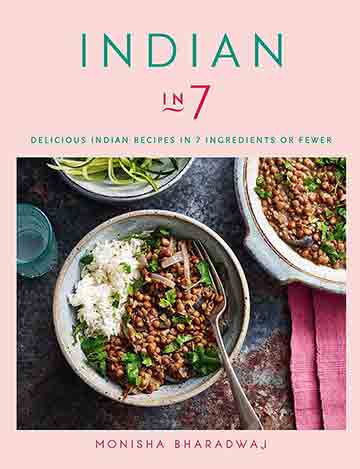
Nutrition
Nutrition information is automatically calculated, so should only be used as an approximation.
Recipe Testers’ Reviews
This tarka dal is a delicious dish that I had all the ingredients for on hand. Straightforward, hearty, and healthy—it brought a smile to my face. I will absolutely be making this again.
I’ll aim to use smaller green chile peppers for it next time and larger tomatoes (or more of them). With two large split jalapeños in the mix, it was a HOT situation. They beautifully disseminated their heat throughout the stew, as they were supposed to, but we prefer our heat a little less five-alarm fire.
This was great served over plain brown rice with fried chicken thighs. I think some yogurt for the heat might be good served alongside next time.
Tarka dal on a weeknight? Yes, please! This recipe was one of my favorite things that I’ve tested in a long time. It was easy to follow, inexpensive, and completely delicious. I lost count of how many times one of us said, “It’s soooooo gooooood.” We ate this as a main dish with some grocery store naan, but it would be great with some basmati or jasmine rice, or some roti (or both). The oil/spices/tomato process goes fairly quickly, so it’s best to have all of the ingredients at the ready to make it a little easier.
I was worried about adding more water to the lentils during the cooking—I didn’t want them to be overly watery. However, I added boiling water three times from my electric kettle during the cooking process and the lentils kept absorbing more and the finished product didn’t seem too watery at all.
Watch closely at the end of your cooking time as my lentils just barely started to stick to the bottom as they disintegrated and finished cooking. Do yourself a favor and buy a large bag of mung lentils, as one time making this recipe will probably not be enough.
This tarka dal is an excellent example of a vegetarian main course. I ate large portions of these lentils over rice for lunch. While they would also pair well with a salad, I had nothing more than the dal and rice and it was a super tasty and satisfying meal.
The tomatoes cooked down significantly to a sauce that blended in with the dal, forming the basis for all the flavors in the dish. I found myself loving every bite that hinted of garlic, so I will probably increase the garlic-ginger paste a smidge the next go around. I used two jalapenos as the chiles which worked fine, but I think the flavor profile might be better served with something else. I would probably try serranos or Thai bird chiles the next time I make this.
Lentils are a wonderful canvas to enjoy the myriad of spice mixes of India, so I just had to give this recipe for tarka dal a try. It’s very straightforward and easy to prepare, and I thought it would pair well with some halibut I had in the fridge. I had a bag of pre-washed mung beans in my pantry, so I was able to save the step of washing the beans before prepping them. Plus, as I keep several 1-inch knobs of ginger in my freezer, it was easy to make the garlic ginger paste (I always have garlic on hand).
I let the water come to a boil while I was prepping the ingredients, which only took about 10 minutes to get ready to cook. Once the lentils were in the pot, I proceeded to get the tomatoes prepared, and cooked them up in less than 10 minutes. I then let them rest in the pot, off heat, and covered. I didn’t need to add any more water to the recipe as suggested.
Since I wanted to serve this over some rice, I started a batch of jasmine rice at the same time as I started the lentils, since that takes about 25 minutes to prepare. I wanted to serve the halibut with an Indian flair, so I made up a spice mix (2 tsp ground cumin, 2 tsp ground coriander, 2 tsp ground fennel, 1 tsp turmeric, 1 tsp curry powder and 1 tsp ground cloves) to put on the fish before sautéing it in some ghee.
I plated the rice, then topped it with the tarka dal, and then placed the spiced halibut on top. It was a great pairing, although my better half said it was a bit spicy, so I’ll reduce the chile to 1 when I make this again to keep her happy.
This is a simple and delicious recipe that is greater than the sum of all the parts. It took about 30 minutes from start to finish and made a lovely vegetarian meal served with naan and a salad.
I’m a fan of spiced and spicy food, and while this tarka dal does have good flavor, in the future I will cook down the onions with the oil and spices first, double the garlic-ginger paste addition, then add the tomatoes and continue to cook it down more for depth of flavor. I’ll also add extra chilis next time as the ones I had imparted only very mild heat to the whole dish.
It would probably pair well with a cilantro-garlic naan, which I’ll try to make ahead in future. I did get 4 decent servings, and served it with homemade soft sweet potato roti (just sweet potato and flour). On the whole, easy to execute, tasty and very adjustable to tastes!
